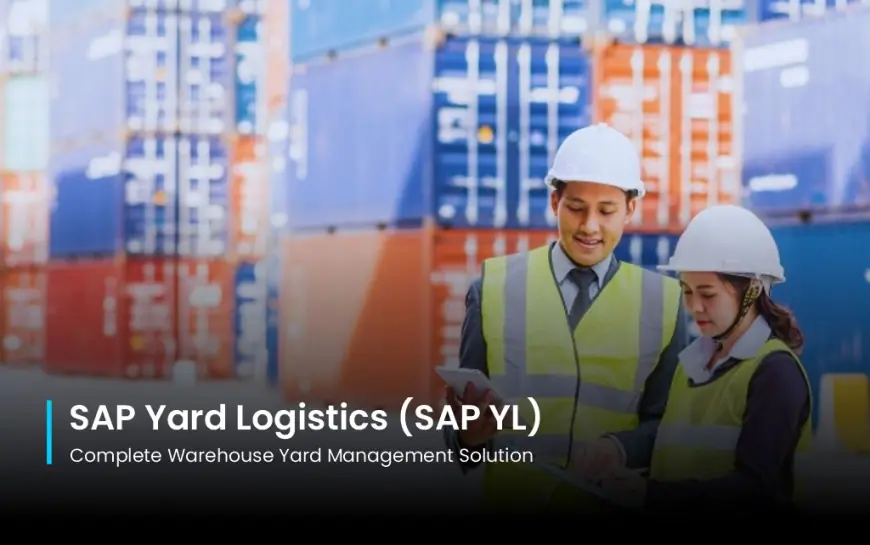SAP Yard Logistics (SAP YL): Complete Warehouse Yard Management Solution
Optimize yard operations with SAP YL – the complete warehouse yard management solution for visibility and control.

SAP Yard Logistics (SAP YL) is a specialized yard management system that bridges transportation and warehouse operations, providing real-time visibility and control over trailer movements, dock scheduling, and yard inventory. This critical component transforms manual yard processes into automated, data-driven operations that deliver measurable ROI and operational excellence.
Understanding SAP Yard Logistics
Core SAP YL System Components
Yard Management Engine: Tracks trailer locations, contents, and status through GPS integration and RFID technology. Advanced positioning algorithms optimize trailer placement based on delivery priorities, reducing search times by 40% and improving yard utilization by 25%.
Dock Scheduling Module: Coordinates appointment booking and resource allocation through intelligent scheduling algorithms. The system considers trailer types, cargo characteristics, labor availability, and equipment constraints, reducing dock waiting times by 30-45%.
Gate Management System: Streamlines check-in/check-out processes through automated data capture using barcode scanners and mobile devices. Integration eliminates manual paperwork while reducing processing times from 15 minutes to 3 minutes per transaction.
Key SAP YL Features
Real-time Visibility Dashboard: Provides complete yard overview through customizable dashboards displaying trailer locations, dock status, and operational KPIs. Mobile applications enable yard personnel to access information and update status remotely.
Intelligent Optimization: Machine learning algorithms analyze operational patterns to recommend optimal yard configurations. The system processes variables including trailer priorities, dock availability, and labor resources to maximize efficiency.
Automated Workflow Management: Eliminates manual coordination through automated task assignment and exception management. Integration with SAP TM and SAP EWM ensures seamless information flow across the logistics ecosystem.
Implementation Strategy
SAP YL Configuration Process
Phase 1: Assessment and Design (4-6 weeks) Comprehensive facility assessment including yard layout mapping, operational workflow analysis, and stakeholder requirement gathering. Critical success factors include accurate master data setup for trailers, carriers, and dock specifications.
Phase 2: System Configuration (8-12 weeks) Technical configuration addressing facility-specific requirements including yard zones, dock configurations, and operational parameters. Integration setup with existing SAP modules and third-party systems including transportation management platforms.
Phase 3: Testing and Deployment (4-6 weeks) Comprehensive testing scenarios covering normal operations, exception handling, and system performance under peak loads. User training programs focus on role-specific functionality and mobile device operations.
Implementation Best Practices
Master Data Governance: Establish standardized processes for maintaining trailer profiles, carrier information, and operational parameters. Regular data quality audits prevent system performance issues.
Change Management: Address both technology adoption and process modifications through comprehensive training programs. Focus on demonstrating operational benefits and efficiency improvements to ensure user adoption.
Business Benefits and ROI
Quantifiable Operational Improvements
Detention Cost Reduction: Organizations achieve 15-25% reduction in detention expenses through optimized scheduling and reduced dwell times. Average ROI realization occurs within 8-12 months of implementation.
Labor Productivity Enhancement: Automated task assignment and mobile workforce management improve productivity by 20-30%. Real-time information access eliminates manual data collection while optimized work sequences reduce travel time.
Yard Space Optimization: Intelligent positioning increases effective yard capacity by 15-20% without physical expansion. The system identifies underutilized areas while preventing congestion in high-traffic zones.
Advanced Analytics Capabilities
Predictive Analytics: Machine learning algorithms forecast yard requirements and recommend proactive operational adjustments. Historical pattern analysis enables capacity planning and resource optimization.
Performance Metrics: Standard KPIs include dock utilization rates (target >85%), trailer turn times (reduced by 25%), and detention costs per shipment. Customizable dashboards provide role-specific visibility.
Industry Applications
Manufacturing Operations
Coordinates complex inbound material flows and outbound finished goods shipments. Integration with production systems enables just-in-time delivery while optimizing cross-docking operations. Typical implementations show 20% improvement in material flow efficiency.
Retail Distribution Centers
Manages high-volume, fast-moving inventory with emphasis on order fulfillment speed. The system coordinates seasonal volume fluctuations while maintaining 99%+ service level commitments. Average order processing time reduction of 35%.
Third-Party Logistics Providers
Enhances operational efficiency across multi-client facilities while maintaining operational segregation. Shared resource optimization capabilities improve asset utilization by 25-30% while reducing operational costs.
Technical Architecture
System Foundation
Built on SAP S/4 HANA in-memory computing platform ensuring real-time processing of complex yard scenarios. Cloud-native architecture supports both on-premise and hybrid cloud deployments with 99.9% uptime reliability.
Integration Framework
Seamless connectivity with SAP Transportation Management, SAP Extended Warehouse Management, and third-party systems through REST APIs and EDI standards. Pre-built connectors accelerate integration with yard hardware including RFID systems and gate readers.
Security and Compliance
Role-based access controls, encrypted communications, and complete audit trails ensure data protection. Multi-tenant architecture maintains data isolation while enabling efficient resource utilization across client operations.
Future Developments
AI and Machine Learning Integration
Advanced optimization engines enhance scheduling accuracy through predictive analytics and automated decision-making. Natural language processing enables voice-activated system interactions and automated exception handling.
IoT Connectivity Expansion
Connected trailer sensors, smart dock doors, and environmental monitoring systems enable autonomous yard operations. Predictive maintenance capabilities reduce equipment downtime by 40%.
Conclusion
SAP Yard Logistics transforms yard operations through intelligent automation, real-time visibility, and predictive analytics. Organizations implementing SAP YL achieve measurable improvements in operational efficiency, cost reduction, and service quality while building the foundation for future logistics innovations.
Success requires strategic implementation planning, comprehensive change management, and focus on user adoption. The platform's scalable architecture and integration capabilities ensure long-term value while accommodating evolving business requirements and technological advancements in modern supply chain operations.
What's Your Reaction?
 Like
0
Like
0
 Dislike
0
Dislike
0
 Love
0
Love
0
 Funny
0
Funny
0
 Angry
0
Angry
0
 Sad
0
Sad
0
 Wow
0
Wow
0



















































